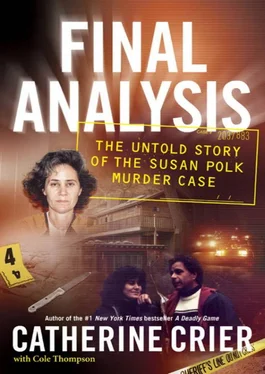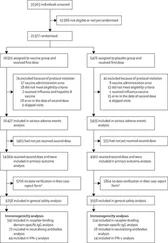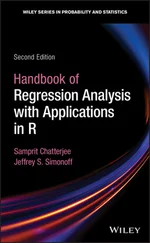“These things can happen time and time again anywhere,” Lawrence said.
Though there was an everyday nature to the situation, the public’s response to the savage death and bizarre history between Felix and Susan was far from average. Within days, Felix Polk’s death quickly became fodder for TV news shows such as Dateline, MSNBC’s Rita Cosby Live and Direct, Inside Edition, and Geraldo. Not long after the autopsy was complete, there were even reports that one of the newsstand tabloids offered as much as fifty thousand dollars to a source close to the case for autopsy photos.
While the Polk case was quickly turning into a media frenzy, it was by no means the first time Orinda had been privy to a high-profile murder investigation. At the press conference, Orinda’s chief of police was quick to point out that the last murder to occur in the sleepy hamlet was in June 1999. Ironically, that homicide also happened on Miner Road, about one-quarter mile from the Polk residence. In that case, the body of a fifty-six-year-old woman was discovered decomposing inside her ramshackle brown ranch house on seven wooded acres at 616 Miner Road. Police later identified the victim as Margaret Bodfish, a wealthy recluse who had reportedly undergone a sex change operation. Diary entries revealed that Bodfish led a double life and had been living for the past sixteen years as a man. Orinda residents knew her as a woman, while residents in Mill Valley, where she owned a second home, knew her as a man.
Bodfish wrote that she “hated her body” and wished to be “beaten to death.”
Investigators suspected that her only son was involved in her murder. Like his mother, Max Wills also kept a diary that contained a list of people he wanted dead; his mother was at the top of the list. But police never got a chance to interview Wills. The thirty-three-year-old took his life in the bathroom of a motel in Santa Monica the day after his mother’s body was found. A maid discovered Wills’ body in a bathtub; he had slit his throat and wrists with a razor blade. A suicide note indicated that he had long suffered from depression, but was reluctant to kill himself while his mother was still alive.
“It would devastate her,” Wills wrote in his diary.
The discovery of a floor safe in the closet of Bodfish’s home six months after the murder temporarily took the spotlight off of the victim’s son and suggested robbery as a possible motive for the murder. Inside the safe, police found sixty thousand dollars in gold and coins. A drill had been found in that same closet during an earlier search of the house, but there was no indication anyone had tried to remove the safe from the floor. With no fingerprints on the drill and the victim’s only relative dead, the case went cold.
While Bodfish’s murder remains a mystery, her memory lives on in Orinda. In her will, she bequeathed her sprawling oak-lined property to the City of Orinda to be used as a public park and recreation area. In July of 2003, the seven-acre parcel was transferred to the Muir Heritage Land Trust and is now an official wildlife sanctuary. Bodfish also left three hundred thousand dollars to the National Organization for Women (NOW), the largest organization of feminist activists in the United States.
Another celebrated murder in Orinda’s criminal history occurred eleven years earlier, in 1984, when Bernadette Protti stabbed fifteen-year old Miramonte High cheerleader and classmate Kirsten Costa to death with a kitchen knife.
Prosecutors argued that Protti was jealous of Kirsten’s popularity and angry that the cheerleader and her friends excluded her from their clique. Priotti denied involvement, but later confessed to the crime. She served less than eight of the nine years she received under the jurisdiction of the California Youth Authority for the murder and was released in 1993 over strong objections from Costa’s family.
The story later became a TV movie of the week that aired in 1994.
And yet despite the attention that both of those cases received, there seemed to be something different about the Polk case. There was no good explanation for the media free-for-all that captivated millions around the country, except that people seemed drawn to the bizarre details unfolding about Felix and Susan. From the relationship’s unhealthy origins to its dramatic conclusion, their story embodied psychological dysfunction in the truest sense. In their own way, each of these characters was haunted by their inescapable pasts—pasts that came to define their entire lives.
While the essential facts had been reported, the case was far from solved. Slowly, contradictory stories where hitting the airways as the Polk sons staked out opposing positions on their family history and their mother’s culpability. Friends began to describe the chaotic household in the press, but despite the reputation that the family was quickly earning, there was still one key player who had to be interviewed: Susan’s mother, Helen.
Chapter Fourteen
HISTORY REPEATS
Helen Bolling was at home in San Diego when her son, David, telephoned on Wednesday, October 16, with the stunning news that Felix was dead and Susan was in jail, suspected of his murder. Though Susan had been incarcerated late Monday evening, no one had contacted remaining family members to alert them to the arrest. Even after police came knocking on David’s door on Tuesday afternoon, he waited to inform his mother of Susan’s arrest. During the phone call, David told Helen that he attended a press conference at police headquarters in Orinda where detectives shared limited details of Susan’s detention. News outlets were reporting that the autopsy revealed a very violent death.
Felix had been stabbed twenty-seven times, the headlines screamed.
Helen could barely comprehend what her son was telling her. “It’s just not possible,” she told him. Susan was a petite woman, she thought. How could her daughter overpower someone of Felix’s size? Besides, if Susan wanted to murder him, would she have planned such a violent and risky encounter? She would never have undertaken such an assault on her own, Helen thought.
Reeling from the news, Helen dialed the Contra Costa Sheriff’s headquarters. She wanted to speak with someone in charge. Detective Mike Costa took her call.
He told Helen that her daughter was refusing to speak with authorities.
“Well, it’s no wonder,” Helen replied. “To experience that kind of event, sometimes you almost can’t talk.”
The detective was silent.
Helen next inquired about the family car. David told her that transit officers had found Felix’s black Saab in the parking lot of the Orinda BART station.
“She just drove it there,” Costa replied flatly.
To Costa’s dismay, transit officers who interviewed taxi and bus drivers servicing the Orinda station failed to discern any evidence or witnesses tying Susan to the Saab. A search of the vehicle showed no signs of forced entry, and investigators had been unable to locate the car keys.
“That doesn’t sound reasonable. How did she get back?” Helen asked the detective. “You can’t walk back. Those roads are too dark and narrow.” The Polk’s home was quite a ways from both the train station and the downtown area. It would have taken at least three hours for Susan to walk from the BART station to her home, Helen told the detective. That just didn’t make sense, she said.
Costa was aware of the distance. His officers had mapped the roughly three-mile route from the Polk house to the station using both city streets and cross-country shortcuts. They determined the time needed to travel that distance on foot to be well under three hours. While he had no evidence to back up his assertion, Costa maintained that Susan had driven the Saab to the BART station immediately after dropping Gabriel at school that Monday morning, and then walked home to retrieve her Volvo wagon for the 12:30 PM pickup at Del Oro High.
Читать дальше











